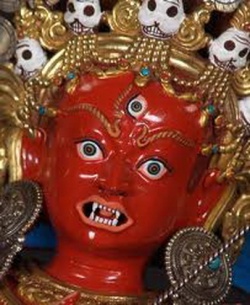Tantras
Tantras ("Looms" or "Weavings") refers to numerous and varied scriptures pertaining to any of several esoteric traditions rooted in Hindu and Buddhist Philosophy. Although Buddhist and Hindu Tantra have many similarities from the outside, they do have some clear distinctions. The rest of this article deals with Hindu Tantra. Buddhist Tantra is described in the article on Vajrayana.
Classes of Hindu Tantra
The word Tantra is made up by the joining (sandhi in Sanskrit) of two Sanskrit words tanoti (expansion) & trayati (liberation) which means liberation of energy and expansion of Consciousness from its gross Form. It is a method to expand the mind & liberate the dormant potential energy, and its principles Form the basis of all YOGIC practices. Hence, the Hindu Tantra scriptures refer to techniques for achieving a result.
The Hindu Tantras total ninety-two scriptures, where sixty four are purely Abheda (literally "without differentiation", or monistic), known as the Bhairava Tantras or Kashmir Śaivite Tantras, eighteen are Bhedābheda (literally "with differentiation and without differentiation" or monistic cum dualistic), known as the Rudra Tantras), and ten are completely Bheda (literally "differentiated"
or dualistic), known as the Śiva Tantras. The latter two (Rudra Tantras and Śiva Tantras) are used by the Śaiva Siddhāntins, and thus are sometimes referred to as Shaiva Siddhanta Tantras, or Śaiva Siddhānta Āgamas. Revelation
Hindus consider the tantras to be divine revelations, or Śruti, imparted by Śiva (Śiva) in the Form of [[Svacchandanath, who created each Tantra as a combination of his five universal energies, or Shakti: cit śakti (energy of all-Consciousness), āNanda
śakti (energy of all-bliss), īccha śakti (energy of all-will), jñāna śakti (energy of all-Knowledge), kriya śakti (energy of all-action). The Tantrika Parampara, or 'Tantric tradition' may be considered parallel or intertwined with the Vaidika
Parampara or 'Vedic tradition'. It is said that Svacchandanath illuminated the Universe, beginning the Sat Yuga, or 'golden age', by revealing these tantras. Through the ages, as the Mahasiddha or 'great masters' of the tantras hid themselves to escape the
touch of the increasingly worldly people, these teachings were lost during the Kali Yuga or 'degenerate age'. As a part of Śiva's grace, Śiva took the FormŚrikanthanatha at Mount Kailaṣ and revealed the ninety-two Hindu tantras to Durvasa and then disappeared into the Ākaśa or ether. Origin
In the Nāth Tradition, legend ascribes the origin of Tantra to Dattatreya, a semi-mythological yogi and the assumed author of the Jivanmukta Gita ("Song of the liberated soul"). Matsyendranath is credited with authorship of the Kaulajñāna-nirnāya, a
voluminous ninth-century Tantra dealing with a host of mystical and magical subjects. This work occupies an important position in the Hindu tantric lineage, as well as in Tibetan Vajrayana Buddhism.
Function
In contradistinction to the Vaidik ritual, which is traditionally performed out-of-doors without any idols nor emblems, the Tantrik ritual is largely a matter of temples and idols. The Tantras are largely descriptions and specifications for the construction and maintenance of temple-structures together with their enclosed idols and lingas—an example of type of text is the Ajita Māhā Tantra. Another function was the conservation as state-secrets of texts for use by royalty to maintain their authority through rituals directed to deities controlling the political affairs-of-state—an example of this is the Śārada-tilaka Tantra.
